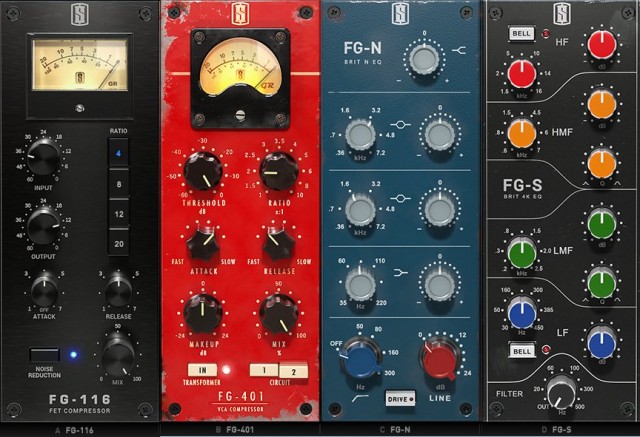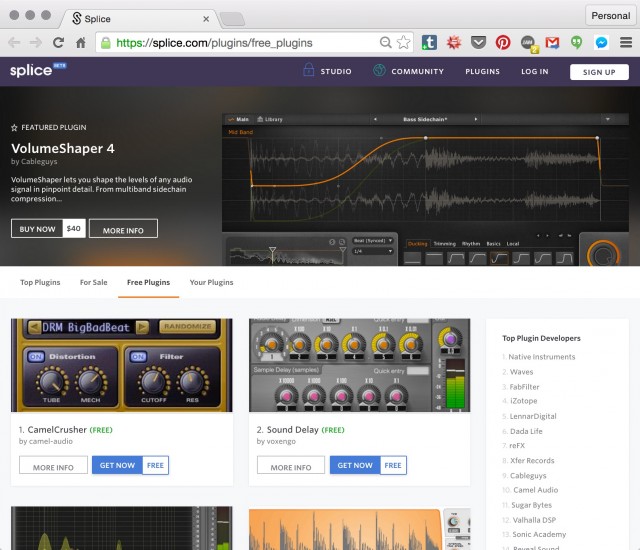It’s been a long time coming, but the month of January has brought more new ways to pay for music creation software than we’ve seen in a few years.
When you want to share a playlist with a friend, you can count on giving them full-length tracks with Spotify. (Sorry, Taylor Swift fans, but everyone else.) If you’re on a tight deadline to finish a video edit, you can pay a small monthly fee to use Adobe Premiere – and send it to the film composer knowing they can do the same, rather than having to buy it outright for a chunk of change. Not so with music production tools, which rely mostly on big one-time payments (sometimes north of a thousand bucks), often with additional copy protection and dependent hardware.
Just in the past few days, we’ve seen some new ways to solve the problem.
$1000 of Plug-ins – For Twenty Bucks?
The most ambitious comes from Gobbler, the cloud backup, sharing, and collaboration service. Gobbler as of this week are re-launching their platform under the tag “spawn.” (Right now, you get just a sign-up for the service.) Collaboration and shop alike will run on the new platform.
Gobbler already offered deep integration with your DAW for sucking up all your related files, backing them up for you, and making it easy to collaborate. But for producers with various mixes of plug-ins, collaboration can be a sticking point – the problem is, your collaborator almost certainly has a different plug-in arsenal than you do. The solution for many users, of course, was simply to either give up – or pirate whatever they didn’t have. (Propellerhead’s Reason is one notable exception to this.)
Spawn now offers a subscription service to make this work. Switch payments on and off on a month-to-month basis — think Spotify and not a membership in your local gym. Once you’re logged into a Gobbler account, your licenses are all activated.
Gobbler tell us they’ve got big plans here. But they’re starting with a damned fine case study: Slate Digital.
Steven Slate is one of the top names in production, bar none, to those who follow such things. (Oh, speaking of Taylor Swift? Yeah, her. Also, Black Eyed Peas, and the folks that help you unfriend people on Facebook, Nickelback.)
But more important than that, Slate Digital (which Slate makes alongside DSP whiz Fabrice Gabriel) make one of the best plug-in libraries you could hope to add to your arsenal. Their Trigger plug-in is one of the best ways to do drum replacement, and they have some formidable options for mastering and analog modeling. (The latter rivals offerings from the likes of Universal Audio, which means the next statement could make some waves – pardon the pun.)
Gobbler have convinced Slate to join their platform and give away their whole plug-in library – for US$19.99 a month, instead of over US$1000 all at once. (Smart money ups that to US$24.99 in order to add Relab Development’s Lexicon reverb emulation.)
That’s everything – now, in the present, and in the future, every tool and every update. The gamble is clearly that the subscription will earn more users, even from would-be pirates.
What’s the catch? Well, with Slate – though not necessarily with the Gobbler Spawn platform generally – you do need a dongle. iLok hardware is required to use the subscription, which I’m sure will scare off some who swore never to touch one again. At least Slate will give you one free with a new subscription, which is good, because I’m pretty sure I lost mine. We’ll see how that goes over and if others bite.
PACE does work software-only, though, which may be okay with more people.
Slate Mix/Master Bundle [slatedigital.com]
Click to Buy, Integrate with Collaboration
Not to be outdone, Gobbler rival Splice are also offering their own plug-in options. Interestingly, while Gobbler’s Spawn seems entirely focused on subscription fees – like adding HBO to your cable TV service – Splice is offering developers a menu of options.
In terms of developers, Splice has even trumped Gobbler, with not one but a swarm of top plug-in makers. There’s Xfer Records, Voxengo, Cableguys, Blue Cat Audio, FXpansion and Tokyo Dawn Records – a virtual who’s who of virtual.
We haven’t yet seen how the Spawn subscriptions integrate with Gobbler. But Splice are describing that the main feature of their new offering. You’ve ppened a collaborator’s project, and don’t have the plug-in? Easy: one click buys it. The emphasis here is more Apple App Store than Adobe Creative Cloud subscription. There’s a huge chunk of free plug-ins, too. (Free-to-play, with in-app purchases – hmm, did the future of plug-ins just flash before my eyes, Angry Birds style?)
It seems Splice are wielding two weapons here: content, and data. They’re assembling plug-ins in a central location, for one. We’ve sort of seen that with a site like dontcrack.com, but – okay, the name is terrible, sounding more like a public service announcement than a service, the site is ugly and unusable, and some of the biggest developers are missing. Splice is building something that looks far more like you’d expect a plug-in store to look.
In that location, they’re adding a lot of additional content. Community members and artists alike can add tutorials and tips and, because these is Splice, even whole DAW sessions demonstrating use of the plug-ins. (If Some Guy In His Basement isn’t appealing to you, Laidback Luke and Henry Fong are reportedly signed on.)
But remember, this is the Cloud – Big Data is there watching you. So Splice can examine who’s using which plug-ins, either overall or by artist, assuming that’s desirable. (I expect some people won’t want that shared!)
And they’re building an SDK platform, as are Gobbler, which they say will benefit both you and your plug-in developer, via:
- License mangement
- Instant access to installers for your OS
- Automatic updates when new versions appear
- Subscription and rental coming in an SDK update
Subscriptions aren’t there yet, but they’re coming. I’ll be interested to see if Gobbler does the reverse – offer one-click purchases instead of only subscriptions.
More: The Future of Plugins on Splice: 1-click Purchase, License Backup & More
If You Build It, They Will… Hey, Where Is Everyone?
To me, both Gobbler and Splice face the same challenge: they have to attract users to these platforms first. And I think users have reason to be reticent: startups with little proven track record may not seem the safest place to invest your plug-in collection. The simple fact is that, for all we use online services, we don’t always collaborate on them.
Gobbler’s Spawn, at least, doesn’t immediately dump you onto the shared Website, which I think is an advantage. In fact, if you were a Slate Digital customer, you might have barely noticed Gobbler at all. You just got a really cheap way to round out your Slate collection for $20 a month. (I expect you’re not so happy if you bought all their stuff, but that should be a relatively small group.)
At the same time, Gobbler and Splice are solving an important obstacle to people collaborating in the first place. Maybe unburdened from the plug-in requirement, more will share.
By the way, from the above description, you may wonder why I’m describing Spawn as more ambitious. The reason: Gobbler are reconstructing their entire collaborative platform with this stuff in mind. As I understand it now, Splice seems to be a plug-in store first; the store is integrated with the rest of Splice, but Splice itself seems not in the middle of a massive overhaul. (Of course, that’s not necessarily a bad thing.)
I have to say, right now, I think the Splice offering is more compelling on first blush. There’s a clear plug-in store, extra content and thus a reason to shop this way, loads of plug-in developers, and no reliance on PACE – with or without the hardware key, PACE dependence could be a deal killer for some users and developers. But each has promise, and we’ll see how this pans out.
Your DAW’s a Subscription, Too
Clarification and correction: The original version of this story claimed incorrectly that SONAR would be available as a paid subscription. That is not accurate. There are both per-month payment plans and a subscription offer that delivers additional content and updates within a time period. But you’re never renting the software, in that failure to pay doesn’t make the software suddenly stop working – so, think payment plans and memberships with bonus content and updates, not Netflix. (Avid Pro Tools, by contrast, is talking “rentals” a la Adobe Creative Cloud.) See full description below.
The above covers plug-ins. But DAWs won’t be far behind, it seems.
Since I wrote this article, Avid announced it would offer a “rental” model for Pro Tools. Just like Adobe’s
Cakewalk meanwhile unveiling memberships with the new version of SONAR. You can opt to pay a monthly payment plan – between US$9.99 and $49.99, depending on version – and then get the latest-and-greatest working on your machine. You can still choose to pay up-front if you prefer, and existing customers get a big break on monthly fees.
Here’s how it works:
If you do buy Cakewalk SONAR in the traditional way – paying all at once – you also get a 12-month Cakewalk “membership” in the deal. That includes updates, fixes, content, and new features for a year from Cakewalk.
If you don’t want to pay all at once, you can also opt for a per-month payment plan. $20 a month gets you almost everything Cakewalk makes, with the $50 a month option giving you the full-featured suite. (By contrast, Native Instruments customers routinely complain about Komplete upgrades – it didn’t have the mix of what they wanted, or they didn’t know if they really needed a particular version, or they just shelled out. A subscription rate gives a steady, flat cost to the user, and relieves them of the fear of missing out on key updates.)
After the 12 months, you can re-up for the “subscription” at a lower per-month rate and continue to get free updates and content for another year. Upgrade purchasers can choose a similar option.
This is a sort of third way between traditional paid purchases and updates and the rental model chosen by Avid and Adobe.
But others might follow Cakewalk’s lead here (so to speak). Cakewalk has been ahead of their time before. Apart from silently introducing a lot of DAW power features before anybody else, they were once the voice in the wilderness on Windows saying 64-bit computation and 64-bit memory access would benefit pro apps – leading not only music apps but serious PC software in general. A few years later, the idea of 32-bit seems antiquated on Mac and PC alike.
A bit like the monthly payment plans you might see for guitars, you can choose how to pay. And either way, subscriptions to Cakewalk memberships are sweetening the deal.
SONAR versions, compared [Cakewalk.com]
My money is on more subscription models of various kinds soon. If you want to bet whether I’m right, first put ten dollars each month into a pot while we wait…
Sorry. Obligatory.
Imagine a plug-in with the power to destroy humanity – and a producer insane enough to use it.
Imagine a Website on the verge of Creation.
Note: subscription service history is one that had me scratching my heads. Readers, which do you remember? One early pioneer – and still a stellar buy – is Harrison MixBus, the absolutely beautiful DAW console built around the open source Ardour, with some fantastic-sounding stuff added in. In fact, this means you’d have a pretty unbeatable mixing desk for about $9 + $19 a month with the two combinations here. Wow.


